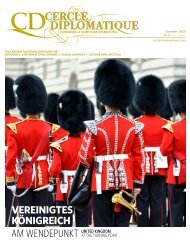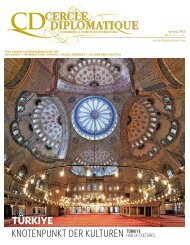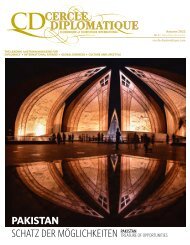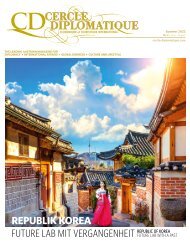CERCLE DIPLOMATIQUE - issue 02/2019
CD is an independent and impartial magazine and is the medium of communication between foreign representatives of international and UN-organisations based in Vienna and the Austrian political classes, business, culture and tourism. CD features up-to-date information about and for the diplomatic corps, international organisations, society, politics, business, tourism, fashion and culture. Furthermore CD introduces the new ambassadors in Austria and informs about designations, awards and top-events. Interviews with leading personalities, country reports from all over the world and the presentation of Austria as a host country complement the wide range oft he magazine.
CD is an independent and impartial magazine and is the medium of communication between foreign representatives of international and UN-organisations based in Vienna and the Austrian political classes, business, culture and tourism. CD features up-to-date information about and for the diplomatic corps, international organisations, society, politics, business, tourism, fashion and culture. Furthermore CD introduces the new ambassadors in Austria and informs about designations, awards and top-events. Interviews with leading personalities, country reports from all over the world and the presentation of Austria as a host country complement the wide range oft he magazine.
Create successful ePaper yourself
Turn your PDF publications into a flip-book with our unique Google optimized e-Paper software.
SAVOIR VIVRE AUSTRIA‘S BAROQUE GARDENS<br />
WASSERSPIELE<br />
Brunnen und Figuren, wie der Pegasusbrunnen im Salzburger<br />
Mirabellgarten, sind essenzielle Elemente eines Barockgartens.<br />
WATER FEATURES<br />
Fountains and figures, such as the Pegasus Fountain at Mirabell<br />
Gardens in Salzburg, are essential components of any baroque garden.<br />
CANALETTOBLICK<br />
Das berühmte Gemälde von Bernardo Bellotto, gen. Canaletto, von 1760 zeigt den Blick vom<br />
Oberen Belvedere über die Barockgärten auf die Wiener Innenstadt.<br />
CANALETTO’S VIEW<br />
The famed painting by Bernardo Bellotto, known as Canaletto, from 1760 shows the view from the<br />
upper Belvedere across the baroque gardens and Vienna’s city centre.<br />
INFO<br />
BAROCKGÄRTEN<br />
Gartentage | Garden Days<br />
30.05.–<strong>02</strong>.06.<strong>2019</strong><br />
schlosshof.at<br />
Die Grüne Schatzkammer |<br />
The Green Treasure Chamber<br />
450 Jahre Gärten und<br />
Pflanzensammlungen in<br />
Schönbrunn.<br />
450 Years of Gardens and<br />
Plant Collections in<br />
Schönbrunn.<br />
bundesgaerten.at<br />
Renaissance after 250 years<br />
“Luckily, we have three paintings by Bernardo Bellotto,<br />
also known as Canaletto, who – around 1760,<br />
when the Imperial Family was already in possession<br />
of the palace – captured the garden in all of its beauty,”<br />
says art historian Katrin Harter, who led the revitalisation<br />
of Schloss Hof ’s baroque garden. After<br />
more than 200 years of varying use, there was almost<br />
nothing left of the original garden as created at the<br />
beginning of the 18th century by Prince Eugene of<br />
Savoy, the powerful Habsburg military commander.<br />
“Schloss Hof is a brilliant example that proves that a<br />
garden paradise thought to be lost can be brought<br />
back to life,” Harter expands. “Although it did overgrow<br />
quite a bit, in large part due to the fact that the<br />
garden had no longer looked after in the 19th and<br />
20th centuries, its baroque foundational structure remained<br />
intact.” The original pathways and stairways,<br />
tree pits and flower beds had remained under a<br />
30-cm-thick layer of soil and could thus be reconstructed<br />
faithfully. “With the final garden terrace, the<br />
baroque masterpiece of Schloss Hof is now complete.<br />
Starting at the palace, the impressive garden has been<br />
uncovered step by step and can now, once again, be<br />
enjoyed in all its splendour,” enthuses Klaus Panholzer,<br />
general director of the operating company that<br />
oversees Schloss Hof. And thus, the garden looks today<br />
the way it had been intended nearly 300 years<br />
ago: 500,000 square metres of tamed nature, structured<br />
by way of staircases and artificial waterfalls, representing<br />
both the power and the artistic appreciation<br />
of its builder.<br />
Garden architecture as power play<br />
“The foundation of every baroque garden is symmetry.”<br />
Eva Berger teaches gardening art at the Technical<br />
University Vienna and is considered an expert for<br />
historical gardens in Austria. “There is a main axis<br />
and there are additional axes. With the help of hedge<br />
walls and alleyways, the garden architecture creates<br />
entirely new spaces,” the author of several books on<br />
historical gardens says to illustrate the layout of baroque<br />
gardens. Additional typical baroque elements<br />
are the inclusion of fine art in the form of statues, water<br />
features and fountains, as well as the unity between<br />
palace and garden. The flower beds on the parterre,<br />
for example, are laid out in front of the palace’s<br />
garden façade in such a way that they provide the best<br />
possible view from the festival hall. “Generally speaking,<br />
however, the baroque garden is also a place for<br />
light strolls, horse-back riding and even carriages,”<br />
Berger expands. If you take a look at the individual<br />
elements that make up such a garden – parterre, bosquet,<br />
orangery – it becomes clear that baroque gardens<br />
came to be during the period of political absolutism<br />
in France. The fact that these gardens were often<br />
power plays that were realised through the use of<br />
enormous sums of money should thus not come as a<br />
surprise. “The baroque garden is a very artificial<br />
world that requires a lot of care. This led to irritations<br />
during the age of the enlightenment in the 18 th century.<br />
These types of gardens were then considered oldfashioned<br />
and were replaced by English landscape<br />
gardens,” the historian elaborates on the dissolution<br />
of the baroque gardening aesthetic.<br />
450 years of collecting plants<br />
Schönbrunn Palace is a rare exception here and has<br />
largely been untouched by renovations. The arrangement<br />
commissioned by Maria Theresa beginning in<br />
1742 has maintained its late-baroque foundation continuously<br />
throughout the years. The continuity of<br />
Schönbrunn reaches back even further in that “Österreichische<br />
Bundesgärten“, the authority that looks after<br />
Schönbrunn Palace today, will celebrate “450 Years<br />
of Gardens and Plant Collections in Schönbrunn”<br />
this year. A whole series of events will give rare insight<br />
into the countless scientifically valuable plant<br />
PHOTOS: TOURISMUS SALZBURG; KHM MUSEUMSVERBAND; ÖSTERREICHISCHE BUNDESGÄRTEN<br />
collections sustained by various Habsburg-commissioned<br />
expeditions. “Many species and families that<br />
had temporarily gone extinct or were facing extinction<br />
have been cultivated in the collections over<br />
hundreds of years,” Daniel Rohrauer, head of Österreichische<br />
Bundesgärten, stresses to emphasise the<br />
role of the botanical collection. Next to exotic types,<br />
such as pineapple, it is especially the various citrus<br />
plants that enjoyed much popularity during the baroque<br />
period, making the orangery an indispensable<br />
element of every baroque garden. “Citrus plants were<br />
identified with the golden apples that the Greek demigod<br />
Heracles had stolen from the Garden of the<br />
Hesperides and were symbolic of the Golden Age<br />
since the Renaissance. A large and diverse citrus collection<br />
was thus a source of prestige and also a type of<br />
power play,” expands Claudia Gröschel, research associate<br />
at the botanical collection of Österreichische<br />
Bundesgärten. <strong>2019</strong> thus marks the perfect opportunity<br />
to pay a visit to a green maze or to an orangery,<br />
stroll around the rare citrus trees and dive into the<br />
botanic world of the Baroque, this defining period of<br />
Austrian history.<br />
Historische Ansichten: barocker Küchengarten; Haemanthus Puniceus – die<br />
Pinsellilie wurde aus Afrika importiert.<br />
Historic views: baroque kitchen garden; Haemanthus Puniceus – the paintbrush lily<br />
was imported from Africa.<br />
Grüne Schatzkammer<br />
450 years gardens and plant collections in Schönbrunn<br />
100 years Austrian Federal Gardens<br />
For 450 years, native as well as exotic plants from all over the world have been collected<br />
at the palace grounds of Schönbrunn. The plant collections came to existence by organized<br />
expeditions and a wide range of networks of botanists, gardeners and envoys and they<br />
were permanently enlarged. The Botanical Collections originally started as a part of the<br />
imperial Kunst- und Wunderkammer at the Viennese residence. Nowadays the unique<br />
plant collections of the republic of Austria are a living botanical museum enhanced<br />
by the Austrian Federal Gardens and make an important contribution to preserving<br />
biodiversity. During the <strong>2019</strong> anniversary year, 12 exhibitions present the<br />
impressing history, unknown botanical plant rarities and exceptional<br />
places of the plant collections. We open our Green Treasury for you and<br />
look forward to your visit!<br />
86 Cercle Diplomatique 2/<strong>2019</strong><br />
Further information:<br />
HBLFA für Gartenbau und<br />
Österreichische Bundesgärten<br />
Office: +43 1 813 59 50<br />
Email: office@bundesgaerten.at<br />
Exhibition-Programme:<br />
www.bundesgaerten.at

















